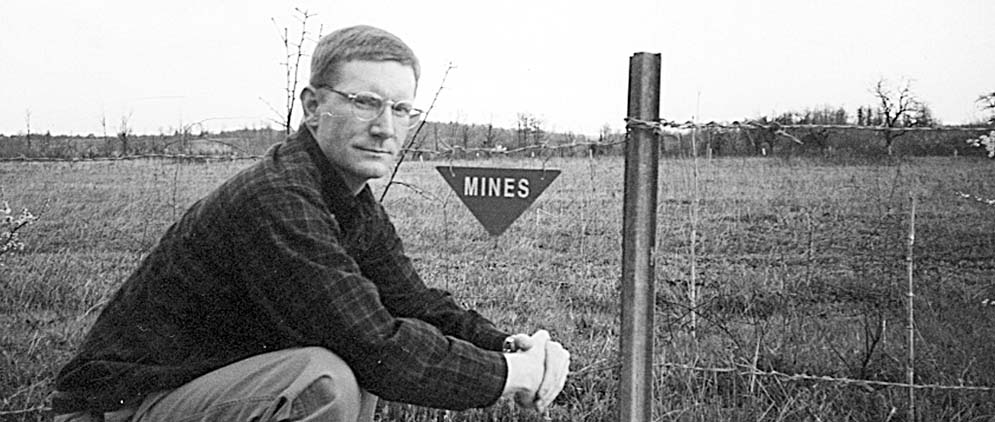By Bob Bishop
America has lost one soldier and a handful of injured to landmines since entering Bosnia in December, 1995. From that time US forces have expended tremendous amounts of time and resources to prevent a recurrence of these casualties. Unfortunately, as we extend our stay for several more years and assist in the civilian implementation of the Dayton Peace Accords (DPA) we can expect to see an increase in minestrikes. It is only a matter of time until more of our fellow soldiers lose their limb or life.
In Bosnia, all US soldiers are overwhelmed with information on UXO – unexploded ordnance. Landmines are the primary category which we are taught to be aware of. As education is the key to avoiding disaster, let’s review what is lurking out there in the landmine category of Bosnian UXO.
Types of Mines in Bosnia
There are two categories of mines in Bosnia: antipersonnel (AP) and antivehicular (anti tank=AT). Both are designed to do just what their names say: destroy personnel or vehicles. How they do it and their manner of emplacement differ, however. Let’s take a look at what our American troops are currently facing.
Antipersonnel
The most common AP mines encountered in Bosnia are the PMA-series, PROM-1, PMR-2A and MRUD. All are manufactured within Bosnia and continue to be used by Muslim (ABiH), Serb (VRS) and Croat (HVO) armed forces. In a fashion which is typical of most Yugoslav armaments they are reliable, well made and quite effective in performance.
These mines attack their victims via two methods: blast or fragmentation. Blast mines are generally buried in the ground from 0-15cm and designed to activate when sustaining a pressure of 3-15kg. This pressure normally comes from direct contact or tripwire. They create a blast usually generated by .1 -.2kg of pressed TNT. A blast mine can cost as little as $3 and results in it being the most cost effective means of removing soldiers from the battlefield. Unfortunately, it is a non-discriminate weapon and can do the same to innocent civilians.
The most common AP blast mines in Bosnia are the PMA-series. It is comprised of the -1A, -2 and -3 mines. All PMA-series mines have just one small metal part – the aluminum covering separating the detonator cap from the main charge. They are almost impossible to detect and are essentially waterproof. The PMA-3 is particularly feared as it has a rubber coating completely covering it and a lifespan measured in years.
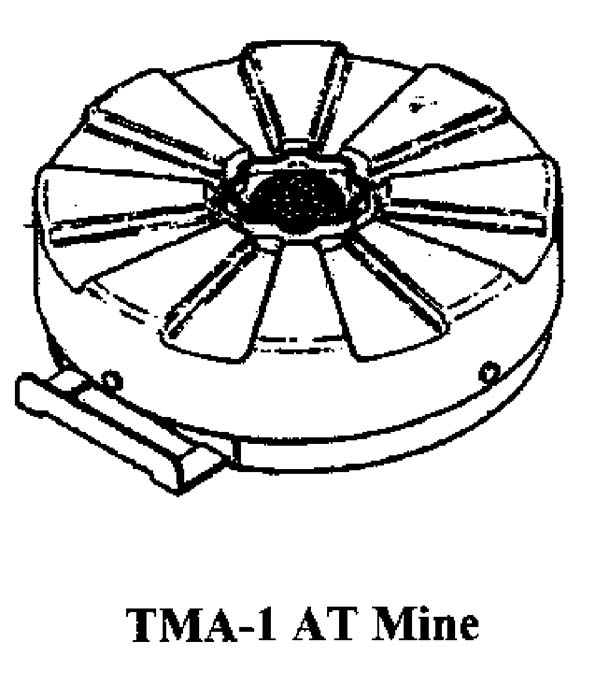
To start the firing train for the typical PMA-3 there must be at least 3kg pressure to activate the UPMAH-3 fuze. This fuze is a chemical friction igniter which contains potassium chlorate, red phosphorus and glass. The activated fuze then sets off the M-17 P2 detonator containing tetryl, lead azide and lead styphnate. When the P2 ignites it sets off the main explosive charge which is 35g of tetryl. A few milliseconds later another victim is claimed.
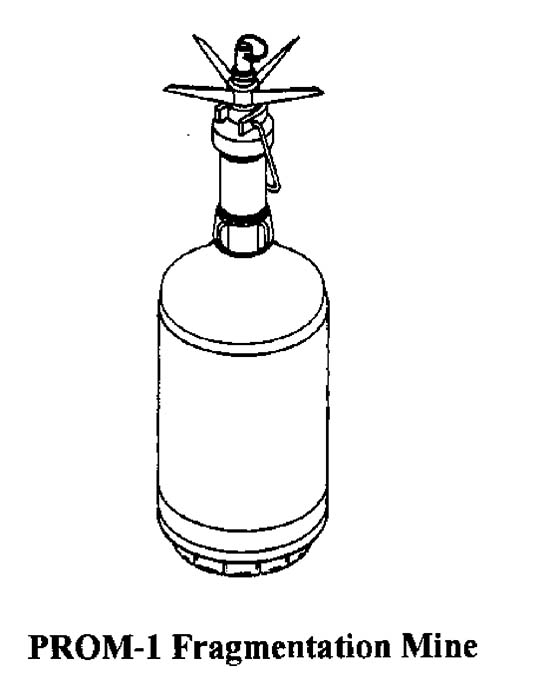
The most common AP fragmentation mines in Bosnia are the PMR-2A, PROM-1 and MRUD. These mines all are usually employed above the ground and project shrapnel over a 0-50m hazard radius. Normally they are activated by trip wire, though the MRUD may be command detonated. Essentially, they are huge shotguns.
The PMR-2A resembles the old WWII pineapple hand grenade which is attached to a wooden stake and mounted above the ground. It has nine rows of external iron serrations which are blown outward in a 360 degree arc when tripwire detonated. It takes less than two minutes for a soldier to emplace a PMR-2A and when activated by 3kg of pressure will detonate with 100g of TNT.
The PROM-1 is very similar to our “bouncing Betty” mine. It is normally buried 3cm below the ground. Once activated by tripwire (3kg) or fuze (9kg), it delays for 1-2 seconds so the victim can clear the immediate area and give it bounding room. The mine will then blast upwards and explode .7m above the ground with 425g of TNT when the internal striker is released. The hazard radius is 22m. As it is normally buried the emplacement time is somewhere around 5-10 minutes.
The MRUD is an almost exact copy of the US M18A1 Claymore mine. It is a directional mine which contains 650 steel balls each of which are 5.5mm in diameter. Upon detonation via tripwire (5-10kg pressure) or command “clacker” the 900g of TNT will literally tear apart all exposed victims up to 50m away. As the clacker is connected to the MRUD via a 30m cable it is an excellent weapon to initiate an ambush or fire down the alley of a street. Emplacement time can be less than a minute.
Antivehicular
The ABiH, HVO and VRS primarily use three types of AT landmines: the TMM-1, TMA-series and TMRP-6. These Bosnian AT mines use the blast or plate charge methods to do their work. The blast effect, as described earlier, uses the force of the blast itself to do the damage. A plate charge is more technically complex and uses the detonation to drive a hardened steel penetrator – or plate – through the soft underside of the vehicle. Some of the lesser-used Bosnian mines used the shaped charge effect for equipment destruction. Due to their scarcity they will not be discussed.
The TMM-1 is a blast effect mine which is most commonly used in roadblocks and similar “quickie” situations. Paramilitary units particularly like it. It is cylindrical in shape and activated by the vehicle driving over it. Normally it takes 70kg of force for detonation but can be set to 130kg with the optional pressure plate. A soldier with equipment will easily exceed 70kg, but not 130kg! When activated, the main charge of 5.6kg of TNT will clearly do its job. As it is sheet metal covered the use of minedetectors will easily find it.
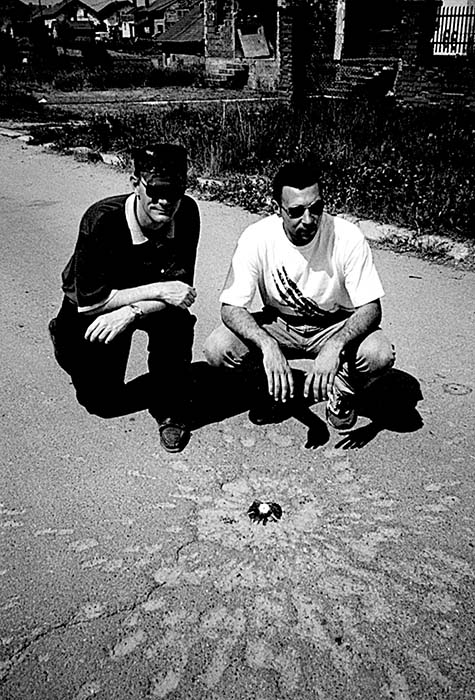
TMA-series mines composed of the -1, -2, -3, -4 and -5 also use the blast effect. They range in size from 5.5-6.5kg of cast TNT and are round or rectangular in shape. They have 1-3 external fuzes (the UTMAH-series) and several wells for fitting of antihandling devices. The TMA-series AT mine is activated when 100-180kg of pressure is placed on it. This pressure limit is determined by the UTMAH fuze being used. The TMA-series is plastic or fiberglass covered and quite difficult to detect. If fitted with antihandling devices it is easier to detect as these devices have a fairly high metal content.
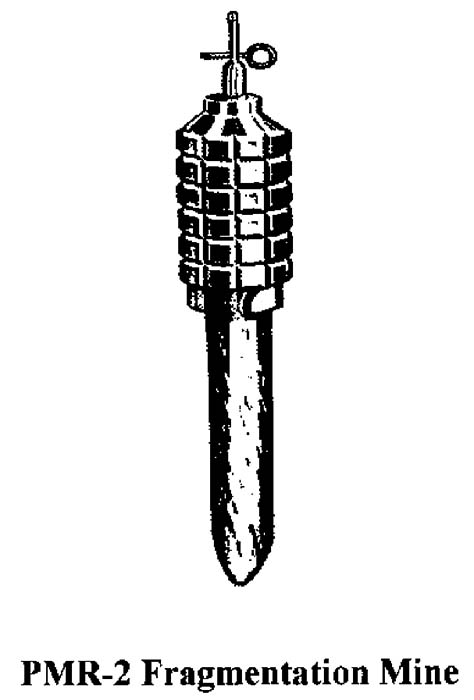
The TMRP-6 mine with its Miznay-Schardin steel plate penetrator can punch through almost any vehicle in Bosnia. It is activated via command, tilt rod or pressure and detonates with 5.1kg of TNT. In the pressure mode it takes 150kg of force to explode and with the 60cm tilt rod only 1.3kg of side force. The TMRP-6 can be mounted sideways on a tree and then use a trip wire attached to the tilt rod. A vehicle will pull the tripwire and the mine will detonate into the side of the vehicle – and mounted troops. As this mine has a substantial amount of metal it can be detected with suitable equipment.
Emplacing Minefields in Bosnia
The minefields in Bosnia were laid for both military and political considerations. On the military side it was for familiar reasons: canalizing, diverting or slowing down opposing forces. It is on the political side where Bosnia becomes a special case. Once friendly forces clear an area of opposing forces and civilians, they use landmines to ensure these undesired elements will not return too fast. Mines literally became surrogate infantry and military police units. This latter category of landmine is causing the most concern in Bosnia.
Military Emplacement
A typical AT mine emplacement pattern in Bosnia is 100m long and 20-50m deep. It will contain 20-40 AT mines with AP mines mixed in. The usual ratio is one AT to three AP mines. These are dispersed about every 4 meters with the depth varied to make detection harder. If the roadway had trafficable shoulders the mines may be emplaced 10-15 meters further to each side to hinder off road travel. As troops tend to ride on the outside of the vehicles, many of the AP mines are the PROM-1. Once it activates and shoots upward .7m its shrapnel will clean the troops off the vehicles.
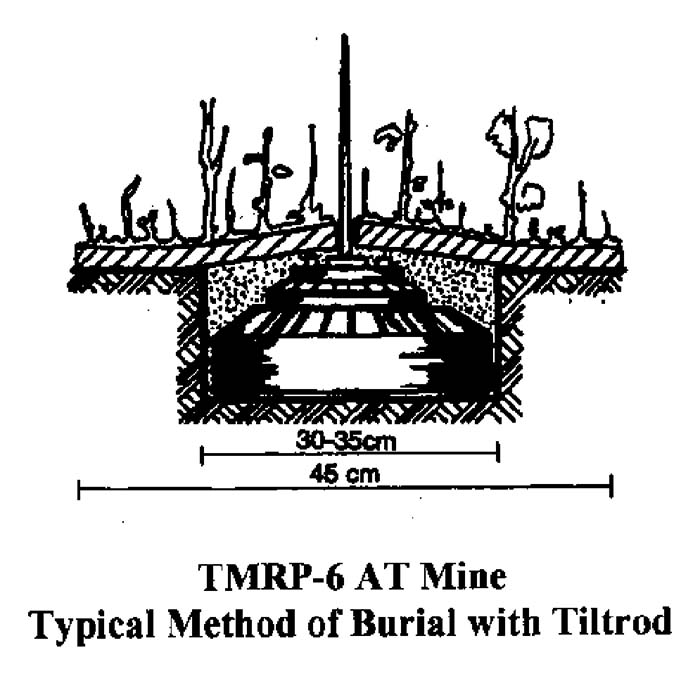
Typical AP minefields contain a mixture of surface and buried mines to reinforce each other’s weak points. AP minefields are anywhere from 50 to hundreds of meters deep. Also, around critical positions they will be found arrayed in depths of 2-3 belts. As the enemy emerges from one belt to dismount into their attack formation they will be suddenly slowed by the next belt. AP mines are normally emplaced 5-10 meters apart. Vegetation is used to conceal the PMR-2A and MRUD while careful dirt replacement obscures the PMA-series and PROM-1. Also, the PMR-2A and MRUD can be linked by 10-30 meters of tripwire for multiple detonations at the same time. This is absolutely devastating to exposed infantry. Finally, PMA-series can be stacked on top of each other so that as the upper mine is removed the bottom one goes off.
Political Emplacement
Politically emplaced landmines usually are composed of the PROM-1 and PMA-series buried mines. Once emplaced they are active for years – which matches the political aims of local officials. The surface-level PMR-2A and MRUD are too easy to spot as their covering vegetation quickly withers and gives off a vivid location marker.
Politically emplaced mines are sited throughout Bosnia, but are primarily concentrated in the 4-km wide Zone of Separation (ZOS). The ZOS is the “no mans land” which separates the opposing forces. Villages within the ZOS are prime targets for mining as neither side wants the other to occupy their former village. Usual places to employ the PMA-series and PROM-1 mines include family gardens, doorways to houses, road shoulders next to the market, water wells, entrances/exits of farm fields and – most chillingly – in local graveyards.
Also, there are economic reasons for political mine emplacement. Bosnia has a limited amount of land suitable for farming. By randomly mining this small area it is very easy to curtail enemy food production and inhibit economic growth. Also, the effect on local health care caused by minestrikes is devastating. A single victim will consume many thousands of dollars of medical care to be stabilized. Multiply this by the estimated 30,000 mine victims and the staggering economic cost to Bosnia begins to emerge.
Demining in Bosnia
The ABiH, VRS and HVO all have the same ex-Yugoslav equipment. There is just not enough to go around as it is extremely expensive and in high demand. Large expanses of mined terrain are normally mechanically demined with a converted T-54/55 tank chassis pushing large steel roller wheels in front of it. The US also has a similar vehicle called the “Panther”. It is a turretless M60 tank chassis, pushing two 44” wide, 5-ton rollers and controlled via a joystick over closed circuit television. These two vehicles are normally used to demine roadways and other flat open areas. They are nearly useless in small areas.
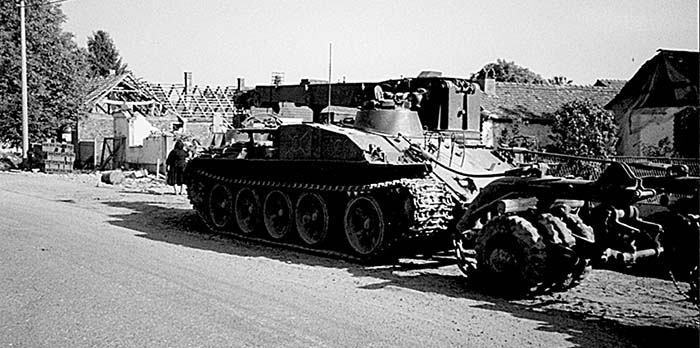
For these restricted areas (which is most of Bosnia) it is historically left to enlisted men and junior officers to clean up. The method is also traditional – handheld mine detectors and “on your knees” probing. The deminer will first put on a very heavy kevlar blast suit and drink at least two liters of water as they are going to sweat a river. Since many Bosnian AP mines are mostly all plastic the mine detector is useless. Probing time! For this extremely hazardous work a deminer will get on his hands and knees with a titanium probe. This probe is the diameter of a pencil and about 40cm long.
Probe rates are so slow that it will take years to clear all of Bosnia – if ever. A fresh deminer will take four minutes to probe one square meter. Every 5cm a probe will be slowly inserted at a 30 degree angle. Rocks, trash, etc. all are assumed to be a mine and treated as such. If there are a lot of rocks or high probability of mines it may take an hour to clear one square meter. Bosnian deminers usually work alone so that one man will not be injured if the other sets off a chain reaction of mines. This is deadly serious business.
Demining in Bosnia is done to “humanitarian” standards. This means there is a 99.8% chance that all mines are cleared. No one can absolutely guarantee that all mines are removed. If the resources were used to do a 100% demining effort then Bosnia will never have a chance of recovery. Apparently it is better that economic life be renewed and have a small number of people maimed than have the entire nation remain financially strangled.
| This article first appeared in Small Arms Review V1N5 (February 1998) |



